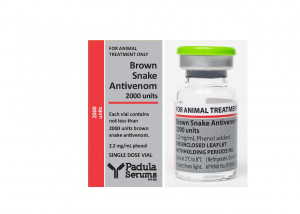Brown Snake Antivenom 2000 units
FOR ANIMAL TREATMENT ONLY
Constituent Statements
Purified equine immunoglobulin proteins less than 200 g/L (2,000 units brown snake antivenom). One unit is defined as the amount of antivenom required to neutralise the lethal effects of 0.01 mg of venom.
Contains 2.2 mg/mL phenol as preservative.
Claims
For the treatment of brown snake (eastern brown, Pseudonaja textilis; Dugite, Pseudonaja affinis; western brown, Pseudonaja nuchalis) envenomation in dogs, cats and horses.
Net Contents
2,000 units brown snake antivenom per 10 mL vial
Directions for Use
ADMINISTRATION OF ANTIVENOM
Route of injection. Antivenom should always be administered via the intravenous route. Subcutaneous or intramuscular absorption is too slow to be effective. To be used by, or under the direct supervision of, a registered veterinary surgeon.
Precautions
PRECAUTIONS IN ADMINISTRATION OF ANTIVENOM
Antivenom is foreign protein when administered to dogs and cats. There is theoretical potential for an acute anaphylactoid response to intravenous administration however this risk is low.
It is recommended to pre-medicate the patient with dexamethasone and antihistamine to minimise the risk of adverse reaction. Antivenom may be diluted in sterile saline diluent, warmed to body temperature, and administered by slow intravenous bolus or infusion. Administration should cease if adverse reaction occurs, but re-administration by slow intravenous infusion may be possible.
The normal appearance of the antivenom is a clear, pale blue to colourless solution. Do not use if the antivenom appears turbid or discoloured.
Side Effects
In rare instances transient angioedema may occur on the lips, face or ears.
Dosage and Administration
INITIAL DOSING
Suspected cases of snakebite by brown snakes should receive an initial dose of 1 vial (2000 units) of Brown Snake Antivenom. Further doses of antivenom may be required based on clinical experience and if signs of envenomation are not effectively treated following the initial dose.
General Directions
Brown Snake Antivenom 2000 units is prepared from appropriately immunised horses. Plasma is fractionated and a purified immunoglobulin concentrate prepared. The antivenom has been shown to neutralise both the lethal effects and procoagulant effects of tiger and brown snake venom.
INDICATIONS FOR USE
Antivenom should be administered as soon as possible after envenomation has occurred.
DIAGNOSIS OF SNAKEBITE
Diagnosis is usually based on clinical signs, coagulation disturbances, biochemical
abnormalities like detection of venom in urine or serum or known encounter with a snake.
SIGNS OF ENVENOMATION
Animals may present with a diverse range of clinical signs depending upon the snake species, time elapsed and total amount of venom received. Potentially lethal envenomation may result in sudden collapse and vomiting within minutes. Apparent recovery may occur within 30 minutes to be followed by a progressive onset of clinical signs. Any or all of the following signs may be observed: weakness, ataxia, flaccid paralysis, dilated pupils, respiratory distress, abdominal breathing, vomiting, agitation, trembling and salivation. Blood may fail to clot and bleeding time extended. Haemolysis and haemoglobinuria or myoglobinuria may be observed. Flaccid paralysis may progress to respiratory paralysis, coma and death.
SUPPORTIVE CARE
Antivenom should not be considered the sole treatment for snakebite. Supportive care must be provided to envenomed animals. Respiratory paralysis, when present, should be treated with supplemental oxygen and if indicated, intubation and mechanical ventilation may be a necessary lifesaving measure. Supportive intravenous fluid therapy is essential to maintain hydration, promote clearance of circulating toxins and avoid complications from haemoglobinuria and myoglobinuria. A consumptive coagulopathy is often present, and care must be taken to monitor for clinically significant bleeding. Haemolysis can be clinically significant in some animals and monitoring of haematological parameters is recommended with appropriate treatment. Pain can be significant in some animals and may require management with opioids or other suitable analgesics. Envenomed animals should be hospitalised and maintained in a quiet, non-stimulating environment.
FURTHER INFORMATION
Padula, A.M., Ong H.M., Kelers K. (2018) Snake Envenomation in Domestic Animal Species in Australia. p505-536 In: Gopalakrishnakone P., Vogel CW., Seifert S., Tambourgi D. (eds) Clinical Toxinology in Australia, Europe, and Americas. Toxinology. Springer, Dordrecht.
Sutherland, SK. Australian animal toxins. (2001). Oxford University Press. ISBN 0 19
5506643 X
Withholding Periods
Zero (0) days.
First Aid Instructions
If poisoning occurs, contact a doctor or Poisons Information Centre. Phone Australia 131126.
Additional User Safety
Take care to avoid accidental self-injection.
Disposal
Dispose of empty containers, outer packaging or expired product by wrapping with paper and putting in garbage.
Discarded needles should immediately be placed in a designated and appropriately labelled ‘sharps’ container.
Storage
Store between 2°C and 8°C (Refrigerate. Do not freeze.) Protect from light.

